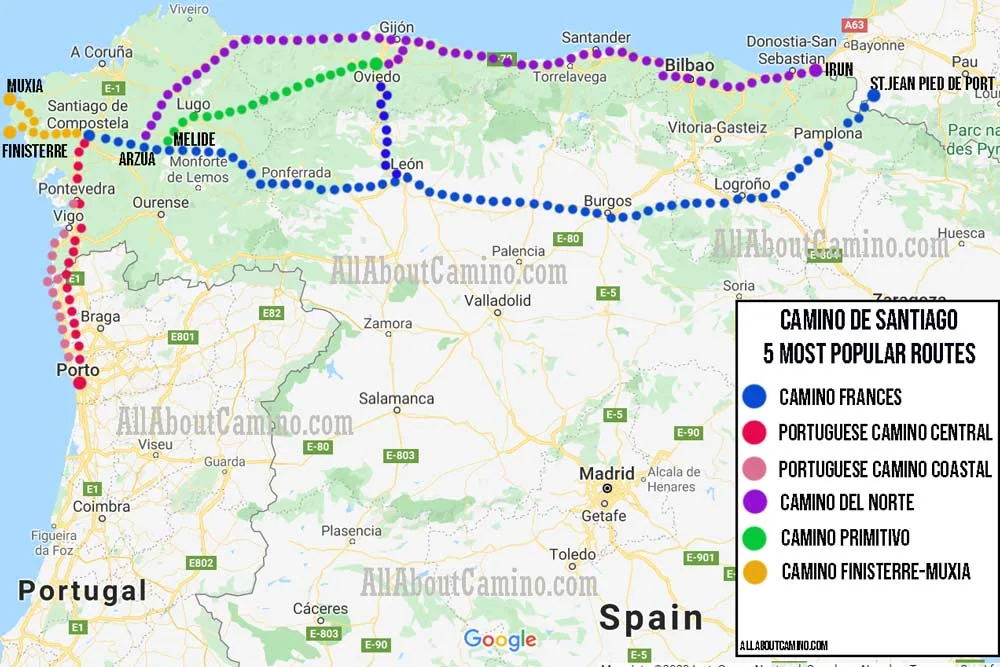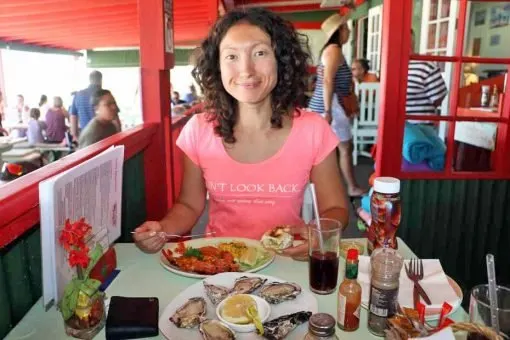
Walking the Camino de Santiago is a unique experience that many people start preparing for a long time beforehand. We have walked nice different Camino de Santiago routes and know how overwhelming it can be to plan the Camino. In this post, we’ve put together our best Camino de Santiago tips and recommendations for planning the pilgrimage.

 A distance marking pole on the Camino Frances
A distance marking pole on the Camino Frances
We have created the Camino de Santiago resource page to make your navigation on our site easier. There you can find all our Camino posts divided into different categories so you can quickly find the information you’re looking for.
Tip to prepare for the Camino
1. Start planning your Camino in advance
If it’s your first Camino walk you might be overwhelmed by all the information. You’ll need some time to process and organize it. The more time you have the less stressful your planning will be. If it’s not your first Camino then you don’t need that much time. Of course you can decide to do the walk last minute and you’ll be fine but not everyone can cope with spontaneous trips that involve long-distance walking.
2. Choose the right route for you
There are many Camino de Santiago routes in Spain and Europe. For the first Camino I recommend choosing one of the main routes because they have more infrastructure and are easier to walk. Base your decision on the desirable distance, time of the year, accommodation type, and business of the route. The Camino Frances and Portuguese Camino are the two most popular routes to walk as the first Camino. Our post on the main 7 routes of the Camino de Santiago might be helpful to make a decision.

 The 5 most popular Camino routes: Camino Frances, Camino Portuguese (Coastal & Central routes), Camino Primitivo, Camino del Norte, Camino Finisterre-Muxia
The 5 most popular Camino routes: Camino Frances, Camino Portuguese (Coastal & Central routes), Camino Primitivo, Camino del Norte, Camino Finisterre-Muxia
3. Decide how far you want to walk
Based on how much time you have and your average daily distance decide how many kilometers in total you want to walk. If you don’t have enough time to walk the route you like you can walk a part of it. There are no rules on where to start or finish the walk. So you can walk a full length of a long route, one of the shorter routes, or a part of a route.
If you want to get the Compostela certificate for completing the Camino you need to walk at least 100 km on any official Camino route. You can find more information on the Compostela here.

 A pilgrim’s package from the Confraternity of Saint James in South Africa. If you have a local Camino association I’d recommend contacting them if you have any questions or concerns
A pilgrim’s package from the Confraternity of Saint James in South Africa. If you have a local Camino association I’d recommend contacting them if you have any questions or concerns
4. Start training for the Camino
Don’t underestimate the walk even if you’re an avid hiker walking the Camino is a different experience. We’re guilty of doing it ourselves when we walked our first Camino. If you don’t exercise regularly and are not used to walking a lot it’s better to start slowly by walking a couple of kilometers a day and build the distance over weeks or even months till you get to 20-25 km. You can follow our Camino training plan.
5. Get a pair of good shoes
The success of your walk depends on them. Do some research, decide which shoes are the best for you and for the chosen Camino route, buy shoes in advance so your feet have time to get used to them. Walking the Camino in new shoes is not a good idea even if it is the best footwear in the world, you’re very likely to get blisters after the first couple of days. You can get some ideas about the best footwear in our Camino shoes post.
6. Set up your budget
Decide how much money you can/want to spend on the trip and then divide it by the number of walking days to see how much you can spend a day. Don’t forget to add transport expenses e.g. plane tickets, etc. Knowing that will help you to see what kind of accommodation, food options, etc. you can afford. Once you have your daily budget you can check in our post on the cost of the Camino de Santiago where you can find breakdowns for different budgets.
7. Decide on the luggage
Whether you want to carry your backpack or use a luggage transfer service and walk with a daypack instead. It depends on you if walking with a heavy pack is too difficult then use the luggage transfer. If you are comfortable with your pack then carry it yourself. If you decide the second, make sure you have a good backpack for the Camino.
8. Don’t overpack
It is only applicable if you are planning to walk with your backpack. Imagine, you carry that weight on your shoulders every day for hours the lighter it is the easier the walk. Don’t take any “just in cast” items, don’t bring too much extra clothes, devices, books, etc. You can get some tips in our Camino packing post.
9. Get a local SIM card
If you don’t have a SIM card from one of the European countries then I recommend buying one before starting the walk. It’s important to stay connected in case you need help. You can usually buy cheap SIM cards valid for 30 days at small convenient shops.
10. Get a Credential (pilgrim’s passport)
It’s a small book with places for stamps. You collect stamps from accommodation places, cafes, churches, etc. along the Camino route. You need the Credential as a prove of pilgrimage to stay in public (municipal) abergues and to the the Compostela certificate at the end of the Camino in Santiago de Compostela. You can buy it at churches, albergues, and information offices on the Camino. It usually costs 2-3 euros.

 Even on a misty day like this on the Camino Frances in season, you can see other pilgrims
Even on a misty day like this on the Camino Frances in season, you can see other pilgrims
Tips for walking the Camino
11. Don’t chase others
It doesn’t matter how far or how far you walk. Some people run the Camino in a couple of days, some take a month to walk the same route.
12. Take care of yourself
If you feel tired, unwell, or have blisters rest for a day or two. Don’t stress out about your itinerary. It’s better to be healthy and skip a stage or two than end up in a hospital.
13. Ask for help if needed
If you walk alone and feel unwell or something bothering you ask people around for help. Other pilgrims, locals, people working in albergues everybody is ready to help.
14. Watch your valuables
Don’t leave your wallet or documents unattended in places where anybody has access to them. Take your valuables with you or lock them in a locker when staying in albergues.

 The Camino is not just a walk, it’s the place where you meet amazing people
The Camino is not just a walk, it’s the place where you meet amazing people
Questions or Comments?
Got any questions or comments? We would love to help! All questions and comments will be answered by us personally in Buy Me a Coffee. Click below and ask away.
Feel free to support our site by buying us a coffee!


The pretty half of Stingy Nomads, responsible for all our land adventures (hiking, climbing, walking the Camino) and following them write-ups. Alya loves walking since she was a child, she prefers to walk 1000 km with a backpack rather than to do a 10 000 km road trip (actually any road trip). Alya is a big fan of Latin America, the Spanish language, and dancing. Every time we go away she desperately misses our dog Chile.
Източник за тази статия
Наши спонсори са:
Български трактори на добри цени при изключително качество






